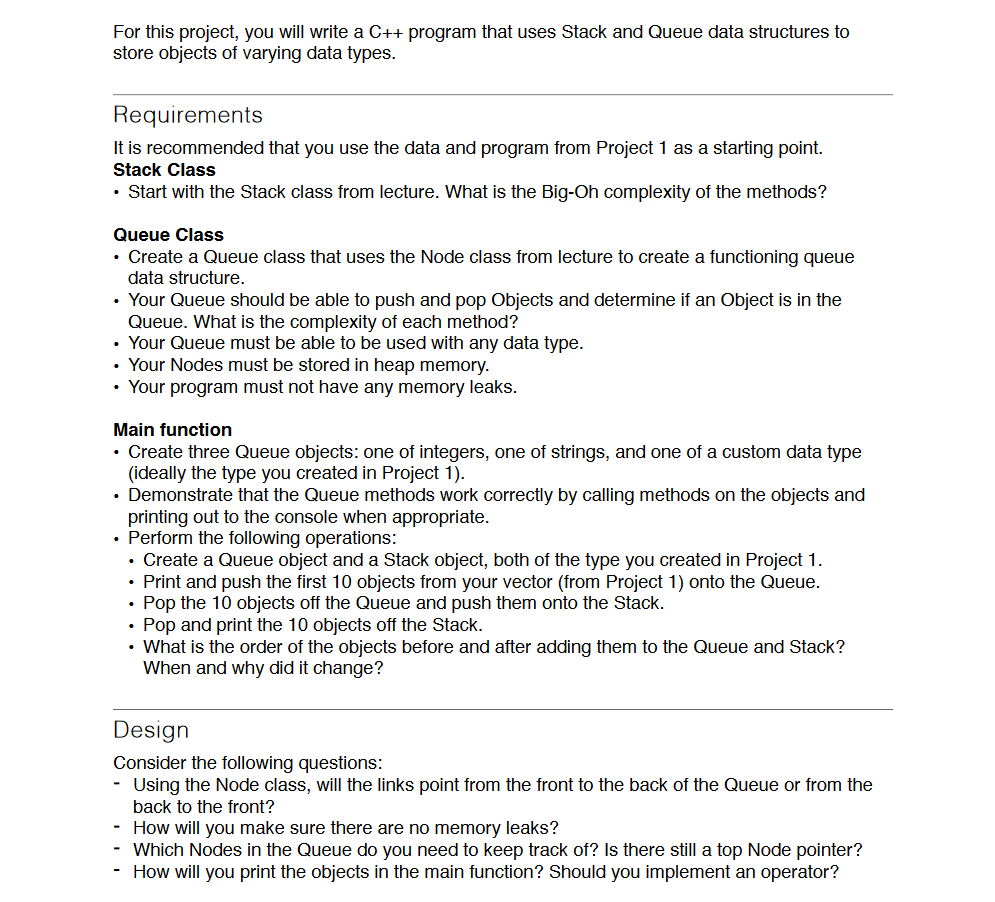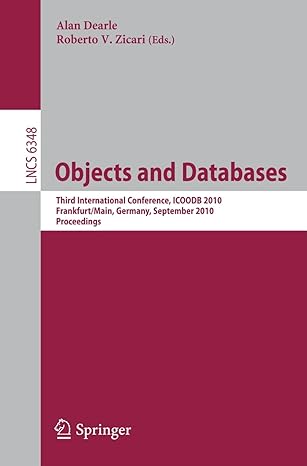Answered step by step
Verified Expert Solution
Question
1 Approved Answer
C++ Program: Below are the instructions, followed by all necessary code/data. Stack.h: #ifndef NODEB_STACK_H #define NODEB_STACK_H #include Node.h #include using namespace std; template typename Object>
C++ Program: Below are the instructions, followed by all necessary code/data.

Stack.h:
#ifndef NODEB_STACK_H #define NODEB_STACK_H #include "Node.h" #includeusing namespace std; templatetypename Object> class Stack { private: // Store the address of the top Node in the Stack Node
Node.h:
#ifndef NODEB_NODE_H #define NODEB_NODE_H templatetypename Object> class Node { private: Object item; // Create a pointer to the next Node Node* next; public: /** Create new node with specified data Have it reference null @param newItem is data to added to new node */ Node(Object newItem) { item = newItem; // explicitly state that the pointer isn't pointing to anything next = nullptr; } /** Create new node with specified data Have it reference nextNode @param newItem is data to added to new node @param nextNode is reference that new Node's next will hold */ Node(Object newItem, Node* nextNode) { item = newItem; next = nextNode; } /** set data field (item) of Node @param newItem, to set item field to */ void setItem(Object newItem) { item = newItem; } // end setItem /** get data field (item) of Node @return item field */ Object getItem() const { return item; } /** set next field of Node @param nextNode, to set next field to */ void setNext(Node* nextNode) { next = nextNode; } /** get next field Node @return next field */ Node* getNext() const { return next; } }; #endif //NODEB_NODE_H Now, the following code is what I've personally written. I wrote code that takes a text file containing information on different football players and their combine results, stores those players as a vector of objects of the class, and prints out those objects. Finally, I wrote a function that calculates the average weight of the players.
Combine.h:
#ifndef COMBINE_H_ #define COMBINE_H_ #include#include #include #include #include #include using namespace std; class Combine { private: string name, college, pos; int height, weight; float dash, bench; public: //CONSTRUCTORS Combine() { name = "John Smith"; college = "University"; pos = "player"; height = 0; weight = 0; dash = 0; bench = 0; } Combine(string name, string college, string pos, int height, int weight, float dash, float bench) { this->name = name; this->college = college; this->pos = pos; setHeight(height); setWeight(weight); setDash(dash); setBench(bench); } //GETTERS string getName() const { return name; } string getCollege() const { return college; } string getPos() const { return pos; } int getHeight() const { return height; } int getWeight() const { return weight; } float getDash() const { return dash; } float getBench() const { return bench; } //SETTERS void setName(string name) { this->name = name; } void setCollege(string college) { this->college = college; } void setPos(string pos) { this->pos = pos; } void setHeight(int height) { if (height //Default value this->height = 0; } else { this->height = height; } } void setWeight(int weight) { if (weight //Default value this->weight = 0; } else { this->weight = weight; } } void setDash(float dash) { if (dash //Default value this->dash = 0; } else { this->dash = dash; } } void setBench(float bench) { if (bench //Default value this->bench = 0; } else { this->bench = bench; } } // Overloaded operators friend ostream& operatorconst Combine &com) { outs return outs; } }; /* getPlayersFromFile reads the file containing the dataset in and assigns each entry its attributes. * The function is similar to what we looked at in class; however, I made one major change which was including stringstream * simply for better handling of values */ void getPlayersFromFile(string filename, vector &players) { ifstream inFile; // Use ../ to get out of the cmake-build-debug folder to find the file inFile.open("../" + filename); // inFile.open(filename); string name = "", college = "", pos = "", header = ""; string temp; int height = 0, weight = 0; float dash = 0, bench = 0; char comma = ','; // check that the file is in a good state if (inFile) { // read in the header line getline(inFile, header); // loop through all the data in the file while (inFile && inFile.peek() != EOF) { // read line getline(inFile,temp); // pass it to string stream stringstream ss(temp); // get name getline(ss,name,','); // get college getline(ss,college,','); // get POS getline(ss,pos,','); // get height getline(ss,temp,','); height = atoi(temp.c_str()); // get weight getline(ss,temp,','); weight = atoi(temp.c_str()); if(ss.good()) { // get 40 yard getline(ss,temp,','); dash = atof(temp.c_str()); } else{ dash=0; } if(ss.good()) { // get bench press getline(ss,temp,','); bench = atof(temp.c_str()); } else{ bench=0; } // create a Combine object and put it on the back of the vector players.push_back(Combine(name, college, pos, height, weight, dash, bench)); } } else { cerr "File not found" /* * avgWeight simply accepts the vector of the Combine class from main and iterates through each object, adding the each entry's (player's) weight to the get the sum before * dividing by the size of the vector to calculate the average. */ float avgWeight(vector &players) { float total = 0; getPlayersFromFile("CombinePlayers.txt", players); for (int i = 0; i //cout } cout "The average weight of a player is: " "lbs" Main.cpp:
#include "Combine.h" #includeusing namespace std; int main() { vector players; getPlayersFromFile("CombinePlayers.txt", players); for (int i = 0; i //This displays the dataset cout return 0; } CombinePlayers.txt:
Name, College, POS, Height (in), Weight (lbs), 40 Yard, Bench Press Johnathan Abram, Mississippi State, S, 71, 205, 4.45, 0 Paul Adams, Missouri, OT, 78, 317, 5.18, 16 Nasir Adderley, Delaware, S, 72, 206, , 0 Azeez Al-Shaair, Florida Atlantic, LB, 73, 234, , 16 Otaro Alaka, Texas A&M, LB, 75, 239, 4.82, 20 Dakota Allen, Texas Tech, LB, 73, 232, 4.77, 23 Josh Allen, Kentucky, EDG, 77, 262, 4.63, 28 Zach Allen, Boston College, DE, 76, 281, 5, 24For this project, you will write a C++ program that uses Stack and Queue data structures to store objects of varying data types. Requirements It is recommended that you use the data and program from Project 1 as a starting point. Stack Class Start with the Stack class from lecture. What is the Big-Oh complexity of the methods? Queue Class Create a Queue class that uses the Node class from lecture to create a functioning queue data structure. Your Queue should be able to push and pop Objects and determine if an Object is in the Queue. What is the complexity of each method? Your Queue must be able to be used with any data type. . Your Nodes must be stored in heap memory. Your program must not have any memory leaks. Main function Create three Queue objects: one of integers, one of strings, and one of a custom data type (ideally the type you created in Project 1). Demonstrate that the Queue methods work correctly by calling methods on the objects and printing out to the console when appropriate. Perform the following operations: Create a Queue object and a Stack object, both of the type you created in Project 1. Print and push the first 10 objects from your vector (from Project 1) onto the Queue. Pop the 10 objects off the Queue and push them onto the Stack. Pop and print the 10 objects off the Stack. What is the order of the objects before and after adding them to the Queue and Stack? When and why did it change? Design Consider the following questions: - Using the Node class, will the links point from the front to the back of the Queue or from the back to the front? - How will you make sure there are no memory leaks? - Which Nodes in the Queue do you need to keep track of? Is there still a top Node pointer? - How will you print the objects in the main function? Should you implement an operator? For this project, you will write a C++ program that uses Stack and Queue data structures to store objects of varying data types. Requirements It is recommended that you use the data and program from Project 1 as a starting point. Stack Class Start with the Stack class from lecture. What is the Big-Oh complexity of the methods? Queue Class Create a Queue class that uses the Node class from lecture to create a functioning queue data structure. Your Queue should be able to push and pop Objects and determine if an Object is in the Queue. What is the complexity of each method? Your Queue must be able to be used with any data type. . Your Nodes must be stored in heap memory. Your program must not have any memory leaks. Main function Create three Queue objects: one of integers, one of strings, and one of a custom data type (ideally the type you created in Project 1). Demonstrate that the Queue methods work correctly by calling methods on the objects and printing out to the console when appropriate. Perform the following operations: Create a Queue object and a Stack object, both of the type you created in Project 1. Print and push the first 10 objects from your vector (from Project 1) onto the Queue. Pop the 10 objects off the Queue and push them onto the Stack. Pop and print the 10 objects off the Stack. What is the order of the objects before and after adding them to the Queue and Stack? When and why did it change? Design Consider the following questions: - Using the Node class, will the links point from the front to the back of the Queue or from the back to the front? - How will you make sure there are no memory leaks? - Which Nodes in the Queue do you need to keep track of? Is there still a top Node pointer? - How will you print the objects in the main function? Should you implement an operator
Step by Step Solution
There are 3 Steps involved in it
Step: 1

Get Instant Access to Expert-Tailored Solutions
See step-by-step solutions with expert insights and AI powered tools for academic success
Step: 2

Step: 3

Ace Your Homework with AI
Get the answers you need in no time with our AI-driven, step-by-step assistance
Get Started


